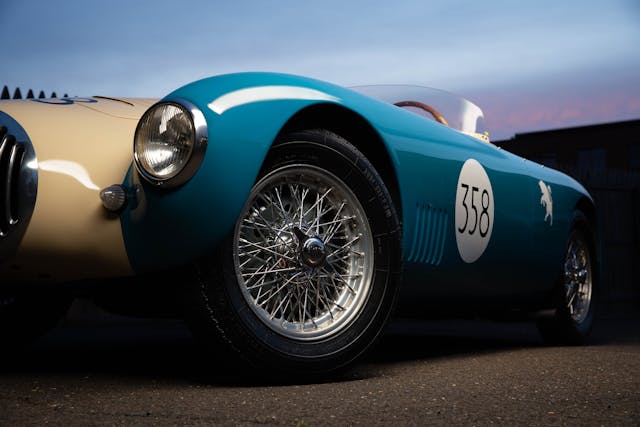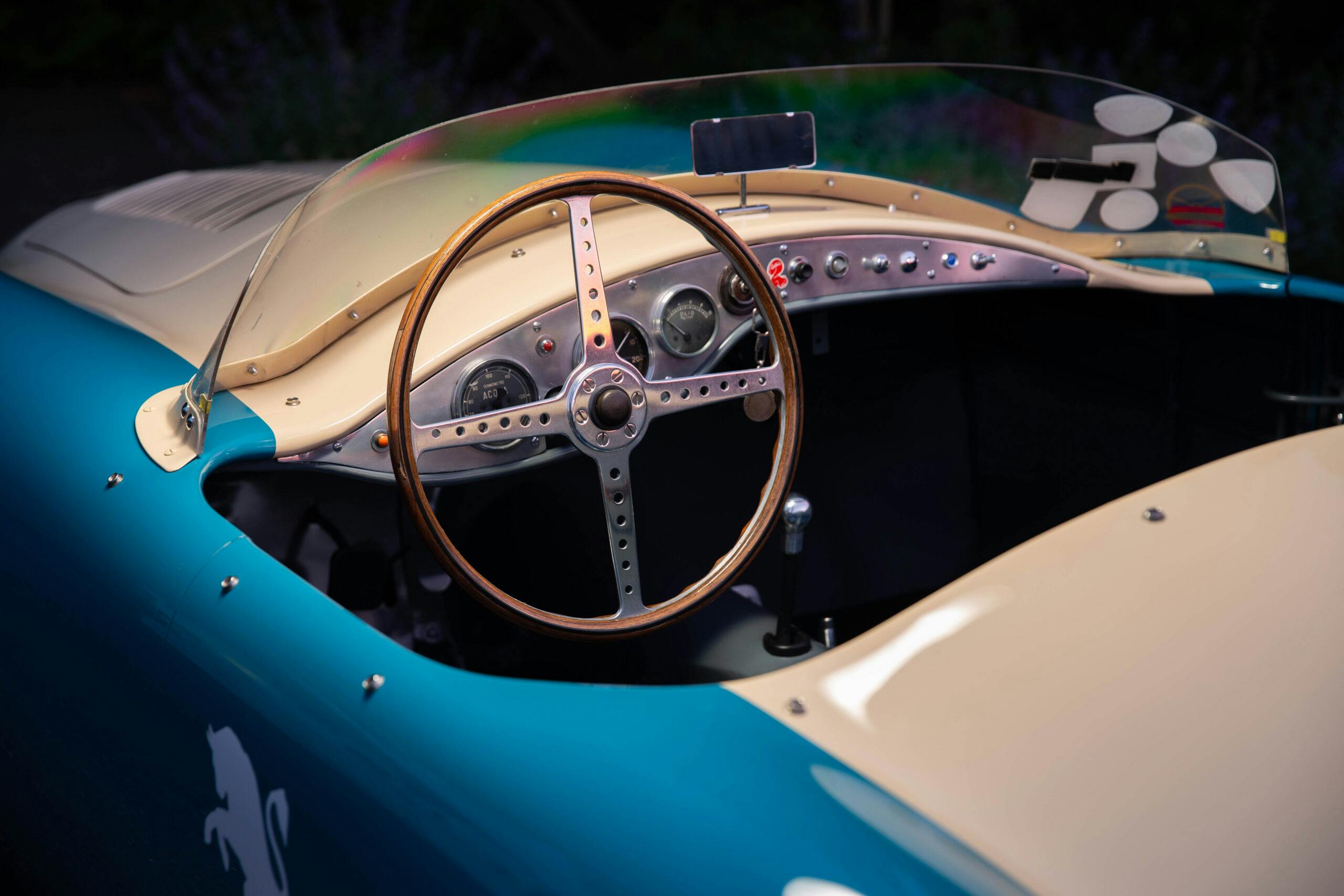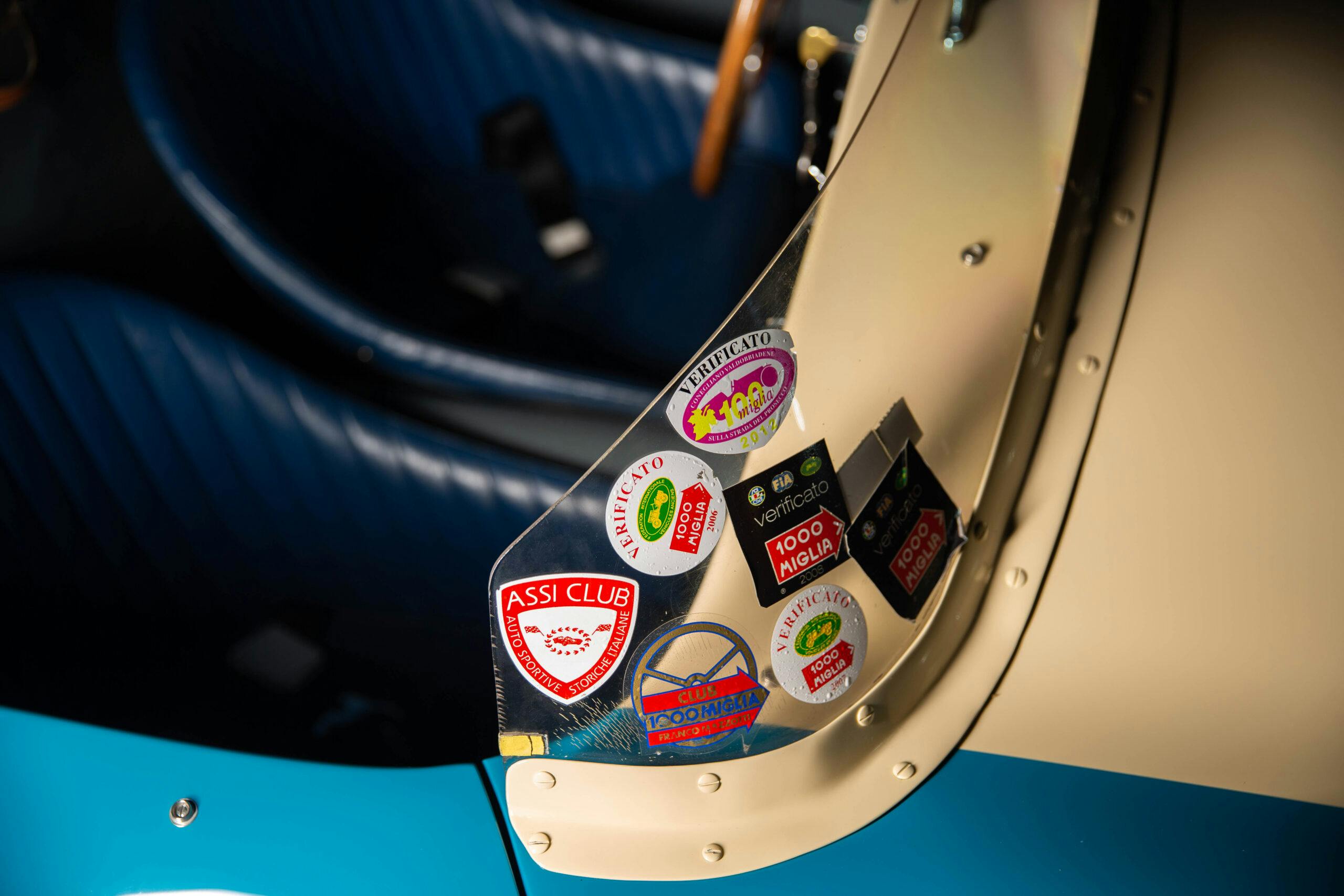OSCA MT4: This obscure ’50s race car is a six-figure Goldilocks
At this year’s Monterey sales, someone famously paid $1,875,000 for a twisted, burned tangle of metal. Equal parts unpleasant and unremarkable to behold, a scrapyard would pay the new owner approximately $650 for the aluminum mess had it not been fire-fatigued. According to marque experts, the singed chassis tag and recorded provenance indicate it was, at one point, a car—a 1954 Ferrari 500 Mondial Spider, to be exact. And, with a heavy checkbook and a skilled workshop, it will be a car once again, ready for a packed schedule of world-class events and prestigious rallies.
A deeply evocative daydream made real—but what’s the payoff here? Aside from the obvious financial upside to mid-century Ferrari ownership, what can be expected of this vehicular Lazarus?
It’s been just shy of 60 years since this Mondial was roadworthy, or even recognizable. The population of folks who were present—let alone cognizant—during chassis No. 0406MD’s appearance at the 1954 Mille Miglia is low, to put it generously. To the average modern enthusiast, cars of this caliber might just as well be grainy black-and-white blurs in a book; if you’re one of the lucky few who attend significant concours or the staging areas of rallies, they’re jeweled sculptures in an art museum. Look, but don’t touch. Watch, but don’t drive.
The average enthusiast likely has a better idea of how the pyramids were really built than how a multi-million-dollar midcentury race car drives. Are they fast? Are they scary? Are they tricky?
Are they even cars?

“It’s the closest you can get to greatness,” Matthew Ivanhoe says with more than a hint of reverence. “A big part of why we love these cars is that cars are tangible pieces of history. Like, I’m sitting and holding the same wheel that Cabianca held while winning the Coppa d’Oro delle Dolomiti.” We grabbed lunch with Ivanhoe in early summer at a gorgeous Italian restaurant just outside New Canaan, Connecticut, where he owns and operates The Cultivated Collector. Renowned for its rotating inventory of some of the world’s greatest analog supercars, Ivanhoe spends the rest of his driving hours behind the wood-rimmed steering wheels of exactly the rarified ephemera we’re talking about.
In the restaurant’s gravel lot, his blue-and-cream 1952 OSCA MT4 ticks over in the shade. It’s a two-time Mille Miglia competitor—in period. Ivanhoe believes the striking barchetta has around 28 major historical races under its fanbelt, split between hill climbs, endurance races, and grueling mountain pass sprints. Even stationary, it’s a vision of past heroism.
Today, it’s simply a device for acquiring spaghetti. I ask Ivanhoe about the average use case for a car like the OSCA MT4. “It’s not a car, it’s an event pass,” he says. “Any of the coolest events you could ever possibly want to go to on planet earth? That car goes. It’s easier to say what events it doesn’t get into than to list what it does.” This includes the modern running of the Mille Miglia, a terribly exclusive event that is often as logistically daunting as it is prohibitively expensive to participate in. Even if you have the cash, finding a car that qualifies isn’t your ticket in, as you’ve got to pass the event’s rigorous selection process that often ends in rejection. But, with the OSCA? Avanti!
Since it’s a documented two-time competitor, the path to the modern Mille as an automatic entry is paved in gold. The corner of the OSCA’s low Plexiglas wind deflector is plastered in competition stickers, as if to prove his point. Ok, so it’s a rolling backstage pass to some of the most romantic automotive events on the planet, but what’s it like when you leave the starting line? It’s a purpose-built race car—surely it’s miserable to operate and impossible to tame, right?
Let’s find out.
From a distance, the MT4 appears as a rather gorgeous children’s car; up close, the barchetta’s Lilliputian footprint is borderline precious. Riding on a wheelbase some three inches shorter than that of a first-generation (NA) Mazda Miata, the OSCA nearly disappears under the beltline of today’s Honda Accord, let alone one of the gazillion crossovers clogging our byways.
As an early MT4-2AD—or Maserati Tipo 4 cilindri—a 1092-cc twin-cam four-cylinder barks out just under 100 hp. Not much when compared to Ferrari’s contemporary 210-hp 225 S, but with just 1400 pounds to scuttle through the Italian countryside, the featherweight MT4 was a veritable giant-killer.
In its 18 years of serious competition, the mighty MT4 logged 939 entries, 449 race starts, 98 class wins, and a stellar 81 overall victories. These laurels were grasped against some of history’s greatest cars; aside from a perpetual stream of Ferraris and early—but very competitive—efforts from Porsche, the Brits terrorized circuits with prototype Jaguars and Astons, while OSCA’s homegrown antagonists included big-budget Alfa Romeos, Lancias, and Maseratis. The MT4’s peak arrived in 1954. Sir Stirling Moss wheeled Briggs Cunningham’s MT4 to an overall victory at that year’s 12 Hours of Sebring, immortalized since as the only overall win for a sports car with an engine displacement less than 1.5 liters.

Meanwhile, the stakes for glory on this New England afternoon have never been lower. Back in the gravel lot, the MT4 rasped to life with a blat of rusty rumble that belied the size of both heart and hoof. Ingress is simple but nerve-wracking; the tiny doors are easy to open and there’s no roof or windshield to rock your forehead against, but since the car’s windowsill struggles to reach my standing hip, you lower yourself into the OSCA’s tub not terribly unlike you would in a go-kart. Mind where you support yourself, however—under your weight, most cockpit protrusions will snap and most aluminum surfaces will bow.
But once you’re in, it’s the view of dreams. Aside from a smattering of patinaed gauges and some scattered, unlabeled switchgear set into the razor-thin aluminum dashplate, it’s entirely a wheel-and-shifter operation. Forward vision is broken only by the slight swell of that curved hood, with everything else falling away beyond the barchetta’s short nose.
As we sit there taking account of the flight controls, the quattro cilindri snorts and spits; it’s time to move. A four-speed manual of OSCA’s own design backs the rorty four, offering an unexpectedly light shift action as I find first. Like all pissed-off half-pints, torque comes relatively high in the tach, so starts are smoothest with some cacophony.
There’s no hiding those competition bones. Throttle response is instant and eager, matched by steering response as direct as a spinal tap. The engine leaks more character from 1.1 liters than any modern V-12 manages with six times that, ripping through Connecticut’s preternaturally calm suburbia with enough mechanical thrash ‘n gnash to shave a cat at 60 feet.

Weighing roughly half as much as an impact-bumper Porsche 911, it moves like a bee on a string, and feels like a frozen espresso fizz thrown in your face. Every input—no matter how minor—is heroic, full, and unfiltered. All the while, you’re fighting biting wind. You’re fighting for road space, too, with modern behemoths like Subaru Imprezas and Audi TTs, realizing that even a minor bump would send you into a violent spin that surely ends in a cartoonish explosion.
Oh well. At least my death arrives in an OSCA. At least it’s interesting. At least it’s a story.
But, we survive this race—er, cruise. I burble into The Cultivated Collector’s quiet parking lot, where small drops of rain are just starting to sizzle on the blacktop. We hustle the roofless little gem into Ivanhoe’s showroom just in time to beat the summer shower. The smell of warm fuel vapor drifts through the garage, a space filled with other midcentury Mille masters from Cisitalia and Ferrari.
I ask Ivanhoe if this was the first time he’s taken out the MT4 just to grab some lunch. “Man, I take that thing to dinner, I’ll stop at the grocery, I’ll go out on a nice Sunday ride with it,” he says, laughing. “These ’50s sports racers—I’m not talking a 356, I’m talking a proper sports racer—are the final hurrah of being able to have that kind of experience while still wrapped in a package that is easily digestible.”

I look back on our quick blast. I’m not sore, hot, hurt, or hobbled after wheeltime in a dedicated prototype race car engineered to run at the peak of capacity for thousands of kilometers. Acclimation involved carefully exploring the clutch, and making sure I didn’t money-shift the four-speed. That’s it.
I don’t think I can say the same about race cars a decade junior to the little OSCA.
Ivanhoe agrees. “By the time you get to the 1960s, things get way more purposeful, for a lack of better description,” he explains. “They become much more hardcore and much, much more focused. “917s, GT40s, the 512S—epic, unbelievable cars—but good god man, you’re not taking one of those to the store to grab a gallon of milk.”
When I interviewed GT40 owners for a feature earlier this year, they echoed this sentiment. I mention this to Ivanhoe. “Cars like that, they’re hot, they’re uncompromising, the clutches are on-off switches, if you’re not moving-moving, they overheat. It’s a race car. It’s a race-race car,” he says. “These ’50s racers are still usable as a car. The suspension is pretty compliant, the motors are pretty usable and easy, they’re not deafeningly, painfully loud.”
It makes sense. Back when Ivanhoe’s OSCA was a prime athlete, portions of the Mille Miglia and Targa Florio were unpaved; suspension compliance was seen as a plus, not a fault. Mid-race fuel stops were also occasionally iffy, meaning these engines couldn’t rely on drinking only the hot stuff. “They’re not running such high compression that you need to run some crazy jungle juice you can’t find at a gas station,” he says. “You run pump gas, you can add an auxiliary fan and then drive them in traffic.” Just like we did.
And short of catastrophe, if something goes sour, there’s little that can’t be fixed by a competent collector car mechanic on the side of the road. “It was super innovative and cutting edge for the time, but we’re not talking about stuff made from unobtainium,” he explains.
I’m hopelessly hooked—but what can I do? At the time of this writing, the Hagerty Price Guide holds the 1100-cc OSCA MT4 at an average value of $986,000, with the crappiest at $789,000 and the best at $1.5 million. A steal, considering an equitable Ferrari sports racer runs between three and five times that, depending on provenance.
Alright, so what’s a reasonable analog? I ask Ivanhoe if a stripped-out, hotted-up twin-cam MGA or a similarly spiced Alfa Romeo Giulietta Spider would scratch this itch. “A stripped-out Giulietta is a fantastic car. I love it. It absolutely gets you 80 percent of the [OSCA] experience, maybe more,” he enthused. “But man … that last 20 percent!”
“But, that’s the thing. An enthusiast with a hot-rod Giulietta and an enthusiast with an OSCA—they’re speaking the same language,” he continues. “We all love the same shit. One’s just a bit spicier than the other.”
I think again on the crumpled Ferrari that sold back in August for $1.875 million. At the time, what a lark—if it’s Ferraris you want, that cash buys you a nice Daytona and a good Dino, with enough left over for a few 308s and Testarossas.
But now, armed with the best kind of bugs-in-the-teeth context, I’m not so sure that Mondial wasn’t one of the best buys of Monterey.
***
Check out the Hagerty Media homepage so you don’t miss a single story, or better yet, bookmark it. To get our best stories delivered right to your inbox, subscribe to our newsletters.







Please correct the typo: I believe OSCA is correct
Done. Thank you for bringing this to our attention.
After my Dad passed away when I was young,I was lucky enough to have a amazing Big Brother from the Big Brother Asociation. I’m not sure of the year,1973 or 1974 my Big Brother Bruce purchased new Jaguar XKE V12 convertible. With me being in high school
this amazing trusting man would let me take it to school. It was one beautiful car. The Colour was like pea soup, sounds gross but I can’t picture a more suitable colour for that car. One or two of the main bearings let go (hopefully it wasn’t my driving) but probably was. He had it fixed and sold it a few years later. How I wish I knew where it was. I would beg,borrow or steal to purchase that car.
You know, our MGA is stripped down and very mildly hopped up (67 motor) and the entire family loves it. I know it is not the same, but it’s fun, drives nice, it’s small, looks awesome, etc. I do really enjoy it. A twin cam would probably be awesome… and if anyone has just the twin cam motor stored under a tarp they want to sell, let me know 🙂
wow…a car like that deserves prose like that !
The OSCA MT4 is pretty.
When I was just a lad of 8 or 9 years of age, my dad took me to the infamous Pebble Beach Road Races on the “old course”. I stood in the soft rain and dreamed of owning the likes of Jaguar 120s, MG TCs, Ferrari 166s, Cadillac-powered Allard J2, and yes, the diminutive O.S.C.A. MT4s. Let’s not forget the Arnolt Bristols and the Buick-powered, Old Yeller. To stay on topic, I remember the bright red O.S.C.A. that kept up with the best of them. It was adorable, but fast and fun to watch. I often wonder what ever happened to that little red roadster…
A very engaging well written and informative article. I believe the prototype’s body was formed from marzepam which the undrrpayed workers were allowed to consume in lue of wages. Of coursr this may only be a room-er.
Enjoyed the content of this piece on the OSCA. That said, the writer’s attempts at cutesiness left me cold.
Goldilocks? As a retried Kindergarten teacher, I have a feeling you meant ‘Cinderella’, no? The car deserves all the appreciation it gets just on appearance alone, much less it’s competition record and pedigree! Gorgeous! But when did it break and enter a bears house?